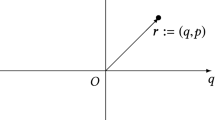Abstract
Dirac’s identification of the quantum analog of the Poisson bracket with the commutator is reviewed, as is the threat of self-inconsistent overdetermination of the quantization of classical dynamical variables which drove him to restrict the assumption of correspondence between quantum and classical Poisson brackets to embrace only the Cartesian components of the phase space vector. Dirac’s canonical commutation rule fails to determine the order of noncommuting factors within quantized classical dynamical variables, but does imply the quantum/classical correspondence of Poisson brackets between any linear function of phase space and the sum of an arbitrary function of only configuration space with one of only momentum space. Since every linear function of phase space is itself such a sum, it is worth checking whether the assumption of quantum/classical correspondence of Poisson brackets for all such sums is still self-consistent. Not only is that so, but this slightly stronger canonical commutation rule also unambiguously determines the order of noncommuting factors within quantized dynamical variables in accord with the 1925 Born-Jordan quantization surmise, thus replicating the results of the Hamiltonian path integral, a fact first realized by E.H. Kerner. Born-Jordan quantization validates the generalized Ehrenfest theorem, but has no inverse, which disallows the disturbing features of the poorly physically motivated invertible Weyl quantization, i.e., its unique deterministic classical “shadow world” which can manifest negative densities in phase space.
Similar content being viewed by others
References
Dirac, P.A.M.: Proc. R. Soc. Lond. Ser. A, Math. Phys. Sci. 109, 642 (1925)
Dirac, P.A.M.: Proc. R. Soc. Lond. Ser. A, Math. Phys. Sci. 110, 561 (1926)
Dirac, P.A.M.: The Principles of Quantum Mechanics (Oxford University Press, London, 1947)
Groenewold, H.J.: Physica 12, 405 (1946)
Kerner, E.H.: private conversation
Kerner, E.H., Sutcliffe, W.G.: J. Math. Phys. 11, 391 (1970)
Cohen, L.: J. Math. Phys. 11, 3296 (1970)
Feynman, R.P.: Phys. Rev. 84, 108 (1951)
Born, M., Jordan, P.: Z. Phys. 34, 858 (1925)
Weyl, H.: Z. Phys. 46, 1 (1927)
Author information
Authors and Affiliations
Corresponding author
Rights and permissions
About this article
Cite this article
Kauffmann, S.K. Unambiguous Quantization from the Maximum Classical Correspondence that Is Self-consistent: The Slightly Stronger Canonical Commutation Rule Dirac Missed. Found Phys 41, 805–819 (2011). https://doi.org/10.1007/s10701-010-9523-2
Received:
Accepted:
Published:
Issue Date:
DOI: https://doi.org/10.1007/s10701-010-9523-2



